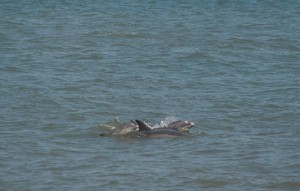
OCEAN CITY — The National Aquarium’s Marine Animal Rescue Program (MARP) last week conducted its annual dolphin count along the coast in Ocean City and Assateague amid concerns over the stress of an unusual mortality event that has lingered on since last summer.
The National Aquarium Animal Rescue Program last Friday was joined by a large group of volunteers for the annual Maryland Dolphin Count and the numbers revealed a significant decline over the number counted during the 2013 event, but aquarium officials are not alarmed. Last Friday, around 50 volunteers of all ages came out between 8 a.m. and 11 a.m. to help record dolphin sightings at four locations, including the Assateague State Park day-use area and in Ocean City at 40th, 81st and 130th streets.
During the sessions, a total of 53 dolphins were counted at the four locations, which was a lower number than last year, likely due to limited visibility caused by fog. Last year, 113 dolphins were counted during the event, which is in the normal range. In 2012, just 31 dolphin sightings were recorded, representing the lowest total in recent years.
The annual dolphin count helps marine mammal specialists capture a snapshot at dolphin populations, reproduction rates and ocean health. Looking at the population numbers over the years can help determine the health of the coastal ecosystem as well as the abundance of prey. Prior to the annual dolphin count on the beach last Friday, a fundraiser was held at Seacrets on Thursday during which nearly $3,000 was raised for the National Aquarium Animal Rescue Program.
What is alarming for MARP officials and their colleagues up and down the east coast is the continued unusual mortality event that has plagued the dolphin population since about this time last year. Around mid-July 2013, the number of dolphin strandings up and down the coast from New York to Florida spiked dramatically, causing NOAA Fisheries to declare an unusual mortality event.
While there were some live strandings, most were found dead and often badly decomposed. The epidemic reached a crescendo late last summer and into the early fall, but National Aquarium Animal Rescue Program Stranding Coordinator Jennifer Ditmar said this week the mortality event has not abated and is still under investigation.
“The Unusual Mortality Event affecting bottlenose dolphins is still open and active unfortunately,” she said.
While there have been no reported live or dead dolphin strandings in Maryland this summer, the numbers collected over the last year since the first spike last July illustrate the scope of the epidemic. For example, from 2007 to 2012, the average yearly number of dolphin strandings in Maryland was five, but that total has risen to 71 from last July to this month. Similar numbers bear out in neighboring Delaware, which saw an average of five dolphin strandings in the five prior years spike to 71 in the last 12 months.
In Virginia, the figures are even more dramatic. Virginia saw an average number of dolphin strandings of 64 from 2007 to 2012, but that total has spiked to 389 since July of last year. The entire east coast from New York to Florida saw an average number of 295 for the prior five years, but that figure has ballooned to 1,370 during the unusual mortality event.
From the beginning, scientists have conducted diagnostic tests, or necropsies, on some of the deceased dolphins and NOAA has determined the primary cause of the mortality event is a virus, more specifically a cetacean morbillivirus, which is characterized as similar to measles in humans, or canine distemper in dogs. Dozens of dolphins have been tested from all over the mid-Atlantic region and the morbillivirus has been detected in most.
Meanwhile, on a lighter note, the Assateague Island National Seashore officials this week provided useful information to help determine the differences between dolphins and porpoises spotted off the coast. For years, many beachgoers and vacationers have debated the differences and the two terms have often been used interchangeably, but they are uniquely different creatures and the National Seashore officials provided some useful information for knowing the difference.
Dolphins and porpoises are two different species of mammals, but it’s hard to tell them apart from the beach. As a general rule of thumb, one spotted from the beach on Assateague or Ocean City is generally an Atlantic bottlenose dolphin. Not only are dolphins more common than porpoises in the Atlantic, they are much more numerous than porpoises worldwide. Most scientists agree there are 32 dolphin species, plus five closely-related species of river dolphin, while there are only six known species of porpoises.
From the beach, it’s important to focus on the shape of the body, head and dorsal fin. Dolphins have slender bodies with pointed beaks and a dorsal fin that looks like a breaking wave. Porpoises have chubby bodies with blunt, rounded beaks and a dorsal fin that looks like a triangle. Another notable difference is that social groups of porpoises are not as large or close-knit as those of dolphins.
